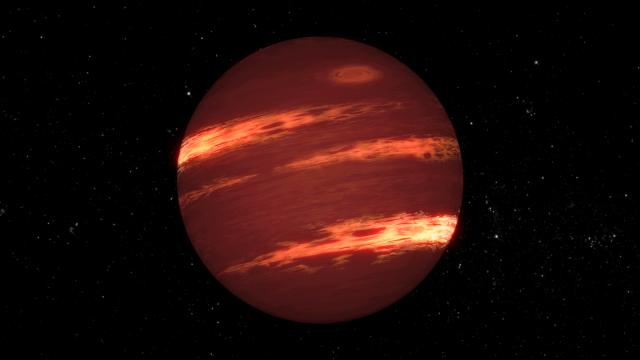Are they stars? Are they lost planets? Brown dwarfs, the galaxy’s dark, wandering orbs, are some of space’s most perplexing features. They’re larger than Jupiter but smaller than stars, glow on their own and, well, they’re just really strange. A new analysis seems to explain at least a few of their mysteries.
Image: NASA/JPL-Caltech
An international team of researchers sifted through telescope data to try and understand the mysterious behaviour of brown dwarfs’ light emissions. After watching a large sample of cold brown dwarfs for a year and a half equaling around a thousand rotations, they came to what might be a surprising conclusion: The best-fit model for their data turned out something that looked a whole lot like planet Neptune. This could have important implications not only for studying brown dwarfs, but for understanding exoplanets in general.
“Our results suggest that large-separation gas giant exoplanet candidates [such as HR 8799bcde and HD 131399Ab],” these well-known exoplanets really far away from their parent star, “which have near-identical temperatures to the brown dwarfs studies here, may also show banded circulation,” the scientists write in the paper published yesterday in the journal Science.
Brown dwarf weather forecasts improved — my latest for JPL #space https://t.co/WKXeB84cHu pic.twitter.com/2Tur0ApqpT
— Elizabeth Landau (@lizlandau) August 17, 2017
One of the brown dwarf’s mysteries centres around its light-curves, that is, how much light it emits over time. Researchers have noticed confusing patterns, including peaks splitting into two recurring peaks, quickly-brightening blips, and patterns appearing in what looks like randomness.
After collecting data from the Spitzer Space Telescope, specifically from the extended missions after it was meant to be decommissioned, the researchers came up with some best-fit models. Those include some features you’re probably already familiar with, including bands of varying brightness and round, bright spots. In fact, the scientists think that brown dwarfs might look a lot like Neptune.
In other words, maybe the best way to explain these dim, star-like things is with the physics of planets. “The data for each brown dwarf can be modelled with two or three bands,” the authors write, with waves of varying brightness kind of like a jet stream with and maxima and minima of light instead of air temperatures and pressures.
Of course, these are just models, not direct observations, and other interpretations are possible. But at least one researcher not involved in this study was excited about the measurements. “I’m amazed. The data they have is very straightforward, like the brightness measurements over time and watching them change at different wavelengths,” Emily Rice, professor of astronomy at the CUNY College of Staten Island told Gizmodo. “The computer models they do and conclusions they draw is super exiting to me.”
Rice was especially excited about the fact that the data came from extended space missions. “When the space mission launches but you don’t know when it’s going to end, you never know how much data can come out of it,” she said.
There are plenty of other implications for brown dwarfs’ atmospheres looking like those of planets. Stars form from clouds of dust, while planets form from disks of dust orbiting stars, said Rice. Brown dwarfs show that something that formed the first way can end up looking a whole lot like the second way (though the elemental composition is different). That also means that studying brown dwarfs can likely help explain many of the specifics of exoplanets, which are generally more difficult to study given the blinding light of the parent star so close by.
“I would say that brown dwarfs are super exciting. Exoplanets get all the hype recently, but we can’t really make these observations with exoplanets,” said Rice. “We were hoping the science would be true but it doesn’t have to be. It’s turning out to be true in more interesting ways than we thought. That’s super cool.”
[Science]
